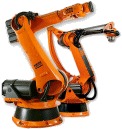Factory automation infrastructure
This article has multiple issues. Please help improve it or discuss these issues on the talk page. (Learn how and when to remove these messages)
|

Factory automation infrastructure describes the process of incorporating automation into the manufacturing environment and processing input goods into final products.[1][2] Factory automation intends to decrease risks associated with laborious and dangerous work faced by human workers.[3][4]
The manufacturing environment is defined by its ability to manufacture and/or assemble goods by machines, integrated assembly lines, and robotic arms. Automated environments are also defined by their coordination with (and usually their systematic integration with) the required automatic equipment to form a complete system.[5]
Automation
[edit]Automation has produced sophisticated parts with similar or higher output qualities with minor quality fluctuation.[6][7] It also can help cut overall manufacturing costs and create safer working environments for workers.[2]

The use of automation in manufacturing started by using technologies such as pneumatic and hydraulic systems in applications where their mechanical advantages could be used to raise output quality and efficiency in production.[8] Complex and highly integrated systems have since evolved, composed of procedures with sophisticated operation drivers.[9] These drivers often are running languages that support 6, 7, and 8-axis controls for sophisticated robotics.[10]
Robotic arm
[edit]A robotic arm is a type of mechanical arm, usually programmable, with functions similar to a human arm; the arm may be the total of the mechanism or may be part of a more complex robot. The links of such a manipulator are connected by joints allowing either rotational motion (such as in an articulated robot) or transnational (linear) displacement. The links of the manipulator can be considered to form a kinematic chain. The terminus of the kinematic chain of the manipulator is called the end effector and is analogous to the human hand.[11]
References
[edit]- ^ "Advantages & Disadvantages Of Factory Automation Infrastructure". BeaconMaster. April 22, 2019. Retrieved January 11, 2021.
- ^ a b Dotoli, Mariagrazia; Fay, Alexander; Miśkowicz, Marek; Seatzu, Carla (August 29, 2019). "An overview of current technologies and emerging trends in factory automation". International Journal of Production Research. 57 (15–16): 5047–5067. doi:10.1080/00207543.2018.1510558. ISSN 0020-7543. S2CID 116633507.
- ^ Richards, Dale (March 14, 2017). "Escape from the factory of the robot monsters: agents of change". Team Performance Management. 23 (1/2): 96–108. doi:10.1108/TPM-10-2015-0052. ISSN 1352-7592. S2CID 55660522.
- ^ "Operations Management in Manufacturing and Service Industries". 2012books.lardbucket.org. Retrieved January 11, 2021.
- ^ Smit, Koos (September 7, 2020). "Factory automation infrastructure". Vertex Automation. Retrieved January 11, 2021.
- ^ Portal, EEP-Electrical Engineering (January 11, 2016). "9 Reasons For Automation Of Manufacturing Processes | EEP". EEP - Electrical Engineering Portal. Retrieved January 11, 2021.
- ^ Marinoudi, Vasso; Sørensen, Claus G.; Pearson, Simon; Bochtis, Dionysis (2019). "Robotics and labour in agriculture. A context consideration". Biosystems Engineering. 184: 111–121. Bibcode:2019BiSyE.184..111M. doi:10.1016/j.biosystemseng.2019.06.013. S2CID 196894141.
- ^ "automation | Technology, Types, Rise, History, & Examples". Encyclopedia Britannica. Retrieved January 11, 2021.
- ^ Read "Virtual Reality: Scientific and Technological Challenges" at NAP.edu. 1995. doi:10.17226/4761. ISBN 978-0-309-05135-4.
- ^ Ben-Ari, Mordechai; Mondada, Francesco (2018), Ben-Ari, Mordechai; Mondada, Francesco (eds.), "Robots and Their Applications", Elements of Robotics, Cham: Springer International Publishing, pp. 1–20, doi:10.1007/978-3-319-62533-1_1, ISBN 978-3-319-62533-1
- ^ "Robotics". Pratt Institute School of Architecture Production Facilities. Retrieved January 11, 2021.
